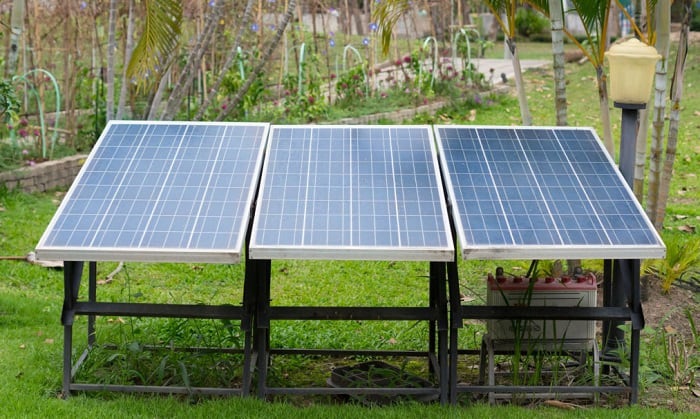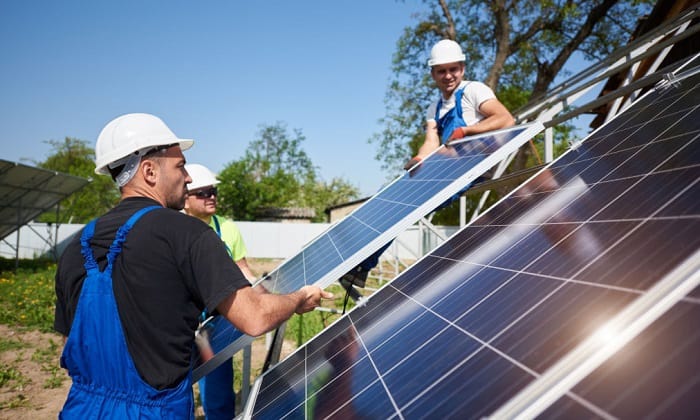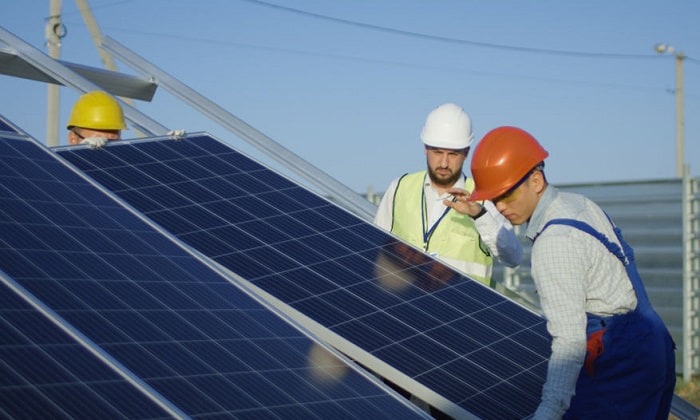Recreational vehicles generally require deep cycle batteries. This is because such batteries save any excess energy generated by the solar panel or generator. Indeed, this means that when there’s adequate sunshine or you’re not running your generator, you could still charge your battery.
Now, the question is, how many watt solar panel to charge deep cycle battery? Generally, you’ll require a 300W size solar panel to charge a 12-Volt 100Ah deep cycle battery with five hours of sunshine. Nonetheless, the required wattage largely depends on the battery capacity and amount of sunshine.
How fast a deep cycle battery can charge will depend on the number of wattages you supply it. Let’s explore more info below.
Table of Contents
- What Makes a Deep Cycle Battery Different from Other Standard Batteries
- The Required Watts of Solar Panel for Charging Deep Cycle Battery
- Solar Deep Cycle Battery Charger
- Are There Other Conditions that Could Influence How Quickly Deep Cycle Batteries Charge
- Does the Number of Solar Panels Minimize Your Charge Time
- Will You Require a Charge Controller
- Final Thoughts
What Makes a Deep Cycle Battery Different from Other Standard Batteries
A deep cycle battery is specifically designed to supply sustained energy for several hours. It is built to be completely charged and then discharged down to roughly 20 percent of its capacity. Fundamentally, what you need to do is to deep cycle its power.
It’s worth noting that there’s no other type of battery that could endure the steady charge and discharge cycle of a deep cycle battery. Therefore, it is the only safe and suitable battery that you should utilize for recreational vehicles.
The Required Watts of Solar Panel for Charging Deep Cycle Battery
Theoretically speaking, you could safely charge this type of battery with a 5W solar panel. Please note that it would not be that efficient, and the battery is likely to take more than one year to charge; however, it could be done.
The truth is, the primary concern here is not the number of wattages required to charge your deep cycle battery since any wattage could carry out that. It is how much wattage it will take to charge your battery within a certain amount of time. On average, this will be within one day of charging.
Additionally, it’s essential to unveil other factors before working out the number of watts required for your battery.
Here are the vital factors you need to consider:
1. Hours of Charge Time Per Day
On average, approximately five hours of adequate charge time per day is required. This is when the sun provides the panel with a sufficient amount of energy that it can convert to power. As you might already know, there are days with full sunlight and days with less sunshine.
2. The Voltage of the Battery
The battery voltage is likely to be 6-volt, 12-volt, or 24-volt. The most common one is 12-volt. Fortunately, the voltage and AH are already labeled on the battery, so figuring them out is not a problem.
3. Battery Capacity (AH)
The capacity of the battery refers to the amount of power that the battery is capable of holding. For deep cycle batteries used in recreational vehicles, this would either be 200AH or 100AH.
And, since you’re expected to discharge a deep cycle battery up to eighty percent, the adequate capacity is below this percentage. Hence, with a 200 AH, it will be 160AH; on the other hand, for 100AH, it will be 80AH.
Solar Deep Cycle Battery Charger
There are so many things to dig up about a solar deep cycle battery charger. Please take into consideration that picking a suitable battery charger will enhance the life of your battery. In addition, picking an inappropriate charger could cause severe damage to your battery.
Manufacturers specifically engineer standard chargers for flooded cell batteries. They charge faster at a superior ampere rate. Please note that these high amps could impair GEL and AGM batteries. As a result, we strongly suggest that you invest in a cutting-edge smart charger that functions with GEL and AGM batteries.
Indeed, the charging speed is the significant distinction between a deep cycle battery charger and a standard battery charger. You can charge flooded batteries at a quicker rate compared to GEL and AGM batteries.
Lastly, as for the size of the charger, carefully check if it has the capability to deliver roughly 10 percent of the maximum amps of the battery. If your battery is graded at 100AH, your battery charger should be able to deliver ten amps.
Are There Other Conditions that Could Influence How Quickly Deep Cycle Batteries Charge
Yes. There are plenty of different conditions that could affect the pace at which the battery charges.
Here are some of them:
1. Whether you’re utilizing power in the recreational vehicle at the same time
If you’re utilizing power in your recreational vehicle at the same time, then you can anticipate that the battery will discharge faster.
For instance, the battery wouldn’t charge if your recreational vehicle was pulling 15AH of power and had a 350W solar panel with a 12-Volt 100AH battery. Each time it obtains a bit of power, you’ll be depleting it away.
2. Solar Panel Wattage
The more wattage was thrown at your battery, the quicker it would charge. But, keep in mind that there is a limit here. Please note that you can’t throw plenty of wattage to the battery and anticipate it to charge within a few minutes.
We highly suggest checking the battery’s manual as the optimal wattage is indicated there. Less expensive batteries generally charge slower because they come with a stringent restriction on the amount of power that flows into the battery.
Should you wish to discover more about solar panel sizing when charging a 12V deep cycle battery, consider going through this site: https://www.renogy.com/blog/what-size-solar-panel-do-i-need-to-charge-a-12v-battery/.
3. How much sunshine you’re obtaining
Substantially, solar panels work at their best when they’re situated in a location where they can absorb direct sunlight. Shades and other sorts of obstructions on the panels can affect their efficiency. Moreover, you shouldn’t expect them to work efficiently during cloudy days.
If any of the following condition occurs, then slower charging is expected:
- In the middle of the winter
- Your RV is parked in a shady location
- Cloudy and rainy days
4. The number of batteries being charged
Most recreational vehicles have more than one battery inside. The solar panel is only able to generate a set amount of power, and this will be distributed across all of the batteries.
Hence, if you had 2 x 12-volt 100 AH batteries, it would take approximately ten hours to charge them using a 250W solar panel.
Does the Number of Solar Panels Minimize Your Charge Time
In most circumstances, the number of solar panels won’t reduce charge time. If you have 2 x 150W solar panels, this will supply 300W of power to the batteries, so it does not change compared with using a 300W panel.
Regardless, there are circumstances where having several solar panels can be advantageous to you. As previously stated, having an obstruction or being in the shade is not ideal for solar panels. So, if your recreational vehicle is parked in a shady location, don’t anticipate the panels to function at their peak capacity.
Due to this, many recreational vehicle owners prefer to position the solar panels at distinct spots on their RVs. This implies that if a single solar panel fails to charge more efficiently, the other solar panel might still function at optimal performance.
The charging capability will still be minimized; however, it won’t be as much as having only one solar panel system setup.
Meanwhile, you might want to watch this video to learn how to charge a deep cycle battery correctly:
Will You Require a Charge Controller
Yes. A charge controller plays a vital role in warding off battery overcharging. Furthermore, it will also aid in ensuring that your battery is not obtaining excessive current.
You might already know that pouring excessive power into the battery at once could lead to overheating. In the same way, if you link thousands of wattages to a 10-amp battery without a charge controller, it will melt.
Having a charge controller is critical because it helps prevent the deep cycle battery from being discharged under the 80 percent mark. This would help in extending the service life of the battery.
Final Thoughts
Determining how many watt solar panel to charge deep cycle battery can be challenging since there are several factors to consider. Theoretically speaking, any solar panel is adept enough to charge your deep cycle battery. But, only a few of them are capable of charging the battery efficiently.
Again, please consider a few factors when working out the number of watts required for your battery. Such factors include:
- the hours for charge time per day
- the voltage of the battery
- the capacity of the battery

I am Kathleen Miller, staff writer and reviewer of the Avasolar team. Working with the team has been a pleasure for me so far, I hope to bring readers useful information by creating detailed and easy-to-follow contents.



